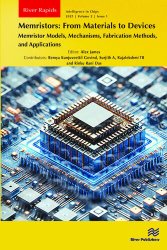Memristors: From Materials to Devices: Memristor Models, Mechanisms, Fabrication Methods, and Applications
- Добавил: literator
- Дата: 28-05-2025, 03:51
- Комментариев: 0
 Название: Memristors: From Materials to Devices: Memristor Models, Mechanisms, Fabrication Methods, and Applications
Название: Memristors: From Materials to Devices: Memristor Models, Mechanisms, Fabrication Methods, and ApplicationsАвтор: Alex James
Издательство: River Publishers
Год: 2025
Страниц: 298
Язык: английский
Формат: epub (true)
Размер: 10.1 MB
This book is a straightforward guide for researchers, engineers, and technology enthusiasts interested in memristors. It covers the fundamentals of memristors, including what they are and how they work, and explores different materials used in them, like binary oxides, perovskites, and new materials like transition metal dichalcogenides (TMDCs). It also explains how memristors are made using methods like physical vapor deposition (PVD) and electrochemical deposition. The book also shows the different types of memristor devices such as non-volatile, spintronic, ferroelectric, polymeric, and molecular memory devices. The book discusses important things like how well memristors work over time, how consistent they are, and how fast they can switch on and off. It also talks about where memristor technology is headed in the future, beyond what's possible with current computer chips.
Memristors have received wide attention due to their futuristic applications such as in neuromorphic computing and memories. The chapter begins with an introduction to memristors thereafter focusing on the classifications.The different switching mechanisms are described in the next section. An overview of the different material systems is presented with a focus on binary oxides and perovskites. Finally, the different fabrication techniques are reviewed, and the structural characterizations are elucidated. The second phase of this chapter describes the role of emerging 2D materials in neuromorphic computing with a special focus on recent developments in memristors, memtransistors, and artificial synaptic devices based on transition metal dichalcogenides (TMDCs). The role of TMDCs in realizing low-power neuromorphic devices is summarized in the following section. Subsequently, the chapter explores the recent advancements in TMDCs-based memtransistors for performing more complex neuromorphic functions. Special attention is paid to the integration of TMDCs into multiterminal memtransistors facilitating gate tunability, energy efficiency, scalability, and reconfigurability in artificial synapses. The last part of the chapter summarizes the development of TMDCs-based photoelectric memristors and optoelectronic synaptic transistors and their applications in biological vision simulation.
The Chapter 2 provides a comprehensive overview of the principles, fabrication techniques, types, applications, and the challenges and future prospects associated with the memristors. The introductory section of this chapter provides a foundational understanding of memristor devices. Subsections, which explore various memristor models, including the linear ion shift model, models based on window function, models for parameter fitting, memristor models for particular devices, etc., shed light on the diverse theoretical frameworks that develop these devices. Additionally, the chapter explains memristor fabrication techniques and discusses the scaling down process and recent advances in fabrication technology, highlighting the continuous evolution in the field. The sections also comprises diverse types of memristors, detailing their unique properties and applications. The types include resistive memristors, polymeric memristors, ferroelectric memristors, resonant-tunneling diodes (RTDs), and spintronic memristors, each providing distinct advantages and use cases. This section serves as a valuable resource for readers seeking a wide understanding of the expanding area of memristor technologies. The subsequent sections focus on the practical applications of memristor-based devices. Non-volatile memory applications are explored, emphasizing the potential of memristors in developing data storage. The discussion extends to crossbar arrays and memory density, elucidating how memristor technology contributes to increased storage capacity. Furthermore, the chapter explores the implications of memristors in enhancing the speed and energy efficiency of memory storage systems, addressing crucial aspects of contemporary technological demands. The final section critically examines the challenges faced by memristor technology and outlines potential future directions. The authors discuss the future scope of memristor technology, focusing on its potential impact on various fields and industries. Overall, the chapter offers a thorough exploration of the foundational principles, diverse types, practical applications, and future trajectories of memristor technology.
Скачать Memristors: From Materials to Devices: Memristor Models, Mechanisms, Fabrication Methods, and Applications
[related-news] [/related-news]
Внимание
Уважаемый посетитель, Вы зашли на сайт как незарегистрированный пользователь.
Мы рекомендуем Вам зарегистрироваться либо войти на сайт под своим именем.
Уважаемый посетитель, Вы зашли на сайт как незарегистрированный пользователь.
Мы рекомендуем Вам зарегистрироваться либо войти на сайт под своим именем.
